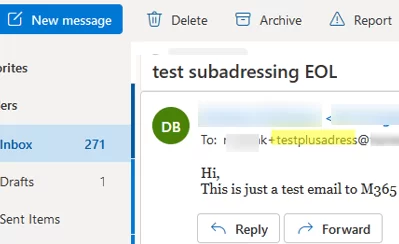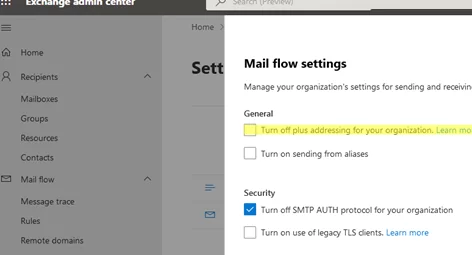Plus addressing (sometimes called subaddressing) allows you to use unique dynamic SMTP e-mail addresses for your mailbox. It is typically used to protect against spam, track marketing companies, and categorize e-mails in a mailbox using inbox rules.
What is E-mail Plus Addressing in
Here is what it looks like:
- Example SMTP address with the basic syntax:
<mailbox_name>@<domain.com> - Plus addressing SMTP syntax:
<mailbox_name>+<tag>@<domain.ru></li>
For example, the SMTP address of your mailbox is [email protected]. If your e-mail provider supports plus addressing, this means that the e-mails sent to the SMTP address like h.werner+word@woshub.com will be delivered to your mailbox.
When processing an incoming email, modern mail services that support plus addressing (Outlook.com, Gmail, Yahoo, iCloud, Exchange Online) deal the “+” character as a special indicator that demands to ignore every character after it and deliver the e-mail to the default SMTP address of your mailbox. This means that you can have an unlimited number of unique SMTP addresses for a single mailbox.
Plus addressing features:
- Plus addresses are only used to receive e-mails, not to send them;
- You do not need to create a list of additional SMTP addresses for your mailbox in advance. An e-mail sent to any of the plus addresses for your mailbox will be delivered;
- Some online forms and services do not allow using the + symbol when filling in the email field;
- If you configure the inbox rules to process e-mails sent to plus addresses, you should use a condition for the field
To/CC/BCC; - They show up as redirects in message tracking logs. As with distribution groups, they resolve to the recipient’s actual address (two trace entries: one from the sender to the plus address and another one from the sender to the actual recipient’s address).
Some scenarios of using plus addressing:
- For example, when I register on a website site1, I give an e-mail like h.werner+site1@woshub.com instead of the real address. And if the email database from the site is leaked to the public, you will be able to trace the leak source and create a filter to automatically move all e-mails sent to the compromised email address to spam;
- It is also convenient to send an e-mail with a note to yourself to h.werner+notes@woshub.com address and it will be automatically moved to the Notes folder using the inbox rules (or you can automatically categorize such a message).
- You can register multiple accounts with unique email addresses on a particular service, but all the e-mails will be delivered to a single mailbox.
- It is useful for marketers to use plus addressing when they are running different promotions and want to track an advertiser’s contact by email address.
How to Enable Plus Addressing in Exchange Online?
Exchange Online (Microsoft 365) has supported plus addressing since 2020. Since April 2022, this feature has been enabled by default for all tenants.
You can enable/disable this feature with the Exchange Admin Center.
- Go to Settings -> Mail Flow;
- Turn off plus addressing for your organization is disabled by default.
You can also enable or disable plus addressing for your tenant with PowerShell.
Connect to your Exchange Online tenant using EXOv2 module:
Connect-ExchangeOnline
Check the feature state:
Get-OrganizationConfig|select *plus*
AllowPlusAddressInRecipients DisablePlusAddressInRecipients ---------------------------- ------------------------------ True False
Microsoft does not recommend manually assigning SMTP addresses with plus characters as SMTP addresses for tenant users. You can find such addresses using the PowerShell command below:
Get-Recipient -Filter 'emailaddresses -like "*+*"' | FT Name, EmailAddresses
In the current on-premises Exchange Server versions, the dynamic plus addressing is not supported, but an administrator can manually add extra SMTP aliases containing + for users (then they will be common SMTP aliases/proxy addresses):
Set-Mailbox j.warner -EmailAddresses @{add="[email protected]"}


